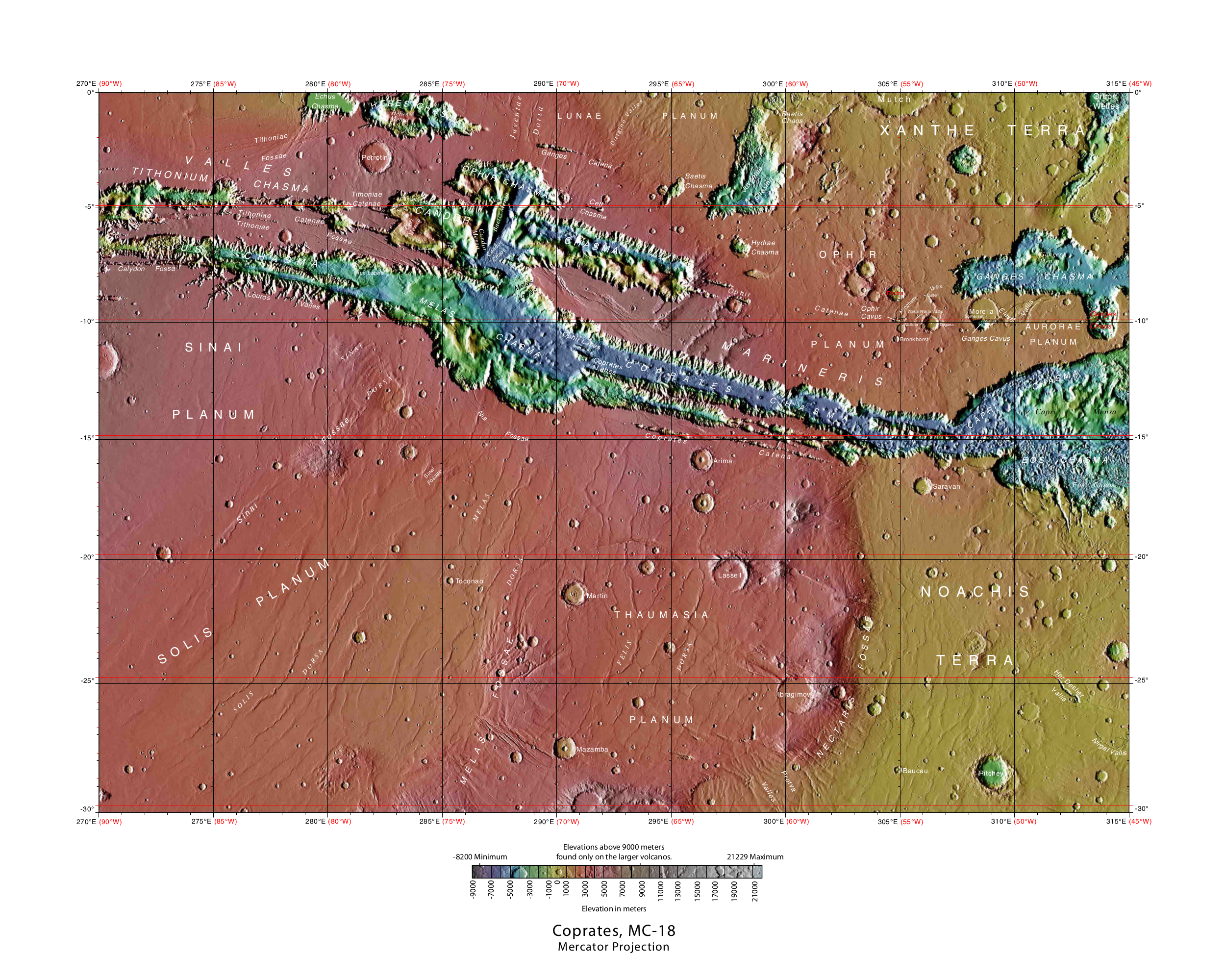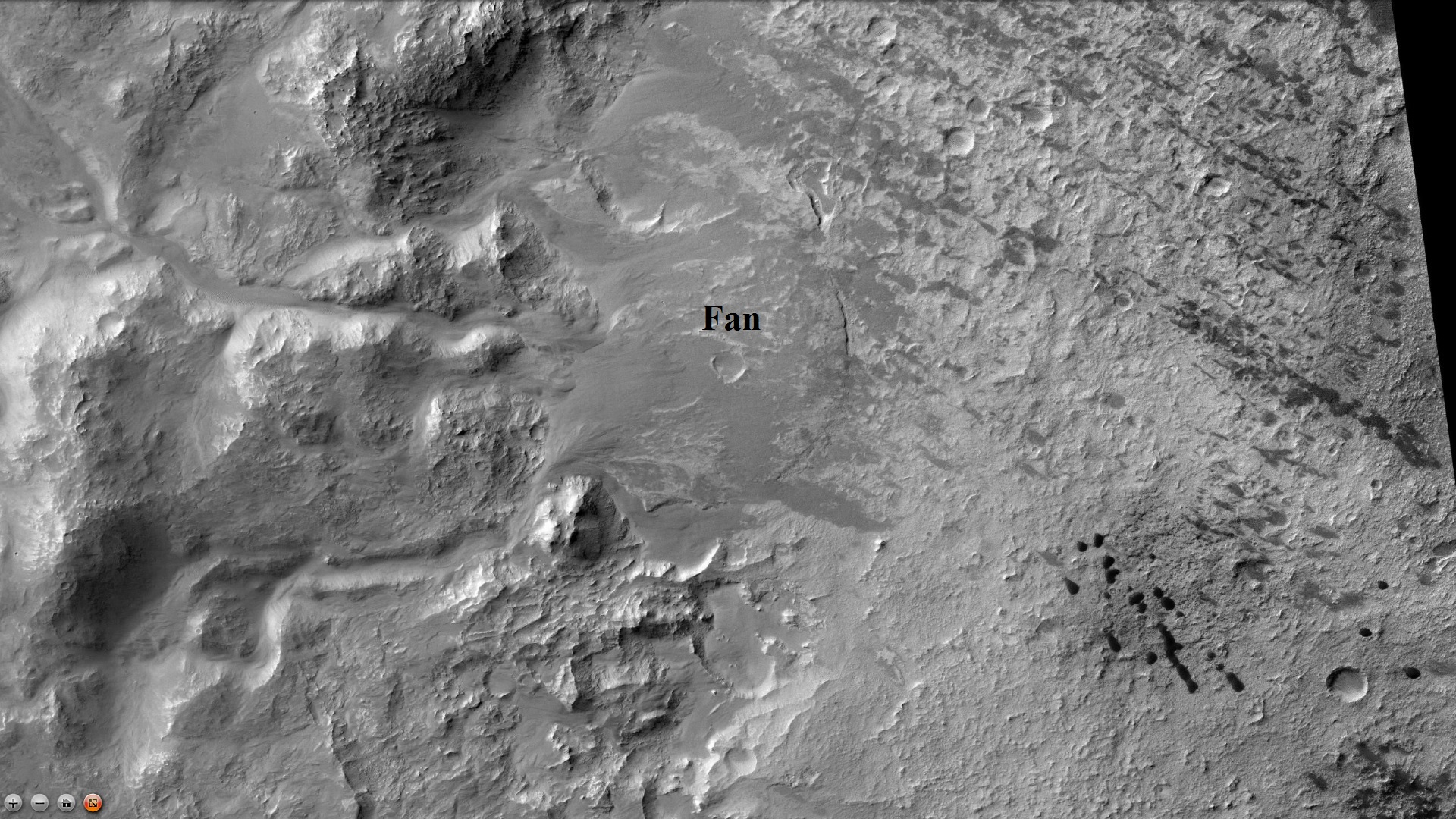|
Ritchey Crater
Ritchey is a crater on Mars, located in the Coprates quadrangle at 28.8° South and 51° West. It measures 79 kilometers in diameter and was named after George W. Ritchey, an American astronomer (1864–1945). Ritchey lies south of Valles Marineris and north of Argyre Planitia, a large impact crater. There is strong evidence that it was once a lake.Sun, V., R. Milliken. 2014. The geology and mineralogy of Ritchey crater, Mars: Evidence for post-Noachian clay formation. Journal of Geophysical Research:119(4), 810–836Alluvial/Fluvial & Lacustrine Deposits in Ritchey Crater marsoweb.nas.nasa.gov Retrieved May 11, 2023 [...More Info...] [...Related Items...] OR: [Wikipedia] [Google] [Baidu] |
Coprates Quadrangle
The Coprates quadrangle is one of a series of 30 quadrangle maps of Mars used by the United States Geological Survey (USGS) Astrogeology Research Program. The Coprates quadrangle is also referred to as MC-18 (Mars Chart-18). The Coprates quadrangle contains parts of many of the old classical regions of Mars: Sinai Planum, Solis Planum, Thaumasia Planum, Lunae Planum, Noachis Terra, and Xanthe Terra. The name Coprates refers to Coprates Chasma, a central trough of the Valles Marineris, named after the Greek name of the Dez River in Persia. The Coprates quadrangle goes from 45° to 90° west longitude and 0° to 30° south latitude on Mars. Coprates quadrangle is famous for depicting the "Grand Canyon of Mars", the Valles Marineris Canyon System. Signs of water exist in this quadrangle, with ancient river valleys and networks of stream channels showing up as inverted terrain and lakes inside of Valles Marineris.Cabrol, N. and E. Grin (eds.). 2010. Lakes on Mars. El ... [...More Info...] [...Related Items...] OR: [Wikipedia] [Google] [Baidu] |
Mars
Mars is the fourth planet from the Sun. It is also known as the "Red Planet", because of its orange-red appearance. Mars is a desert-like rocky planet with a tenuous carbon dioxide () atmosphere. At the average surface level the atmospheric pressure is a few thousandths of Earth's, atmospheric temperature ranges from and cosmic radiation is high. Mars retains some water, in the ground as well as thinly in the atmosphere, forming cirrus clouds, frost, larger polar regions of permafrost and ice caps (with seasonal snow), but no liquid surface water. Its surface gravity is roughly a third of Earth's or double that of the Moon. It is half as wide as Earth or twice the Moon, with a diameter of , and has a surface area the size of all the dry land of Earth. Fine dust is prevalent across the surface and the atmosphere, being picked up and spread at the low Martian gravity even by the weak wind of the tenuous atmosphere. The terrain of Mars roughly follows a north-south ... [...More Info...] [...Related Items...] OR: [Wikipedia] [Google] [Baidu] |
George W
George Walker Bush (born July 6, 1946) is an American politician and businessman who was the 43rd president of the United States from 2001 to 2009. A member of the Bush family and the Republican Party (United States), Republican Party, he is the eldest son of the 41st president, George H. W. Bush, and was the 46th governor of Texas from 1995 to 2000. Bush flew warplanes in the Texas Air National Guard in his twenties. After graduating from Harvard Business School in 1975, he worked in the oil industry. He later co-owned the Major League Baseball team Texas Rangers (baseball), Texas Rangers before being elected governor of Texas 1994 Texas gubernatorial election, in 1994. Governorship of George W. Bush, As governor, Bush successfully sponsored legislation for tort reform, increased education funding, set higher standards for schools, and reformed the criminal justice system. He also helped make Texas the Wind power in Texas, leading producer of wind-generated electricity in t ... [...More Info...] [...Related Items...] OR: [Wikipedia] [Google] [Baidu] |
Impact Crater
An impact crater is a depression (geology), depression in the surface of a solid astronomical body formed by the hypervelocity impact event, impact of a smaller object. In contrast to volcanic craters, which result from explosion or internal collapse, impact craters typically have raised rims and floors that are lower in elevation than the surrounding terrain. Impact craters are typically circular, though they can be elliptical in shape or even irregular due to events such as landslides. Impact craters range in size from microscopic craters seen on lunar rocks returned by the Apollo Program to simple bowl-shaped depressions and vast, complex, multi-ringed impact basins. Meteor Crater is a well-known example of a small impact crater on Earth. Impact craters are the dominant geographic features on many solid Solar System objects including the Moon, Mercury (planet), Mercury, Callisto (moon), Callisto, Ganymede (moon), Ganymede, and most small moons and asteroids. On other planet ... [...More Info...] [...Related Items...] OR: [Wikipedia] [Google] [Baidu] |
Valles Marineris
Valles Marineris (; Latin for ''Mariner program, Mariner Valleys'', named after the Mariner 9 Mars orbiter of 1971–72 which discovered it) is a system of canyons that runs along the Mars, Martian surface east of the Tharsis region. At more than long, wide and up to deep, Valles Marineris is the largest List of largest rifts and valleys in the Solar System, canyon in the Solar System. Valles Marineris is located along the equator of Mars, on the east side of the Tharsis Bulge, and stretches for nearly a quarter of the planet's circumference. The canyon system starts in the west with Noctis Labyrinthus; proceeding to the east are Tithonium Chasma, Tithonium and Ius Chasma, Ius chasmata, then Melas Chasma, Melas, Candor Chasma, Candor and Ophir Chasma, Ophir chasmata, then Coprates Chasma, then Ganges Chasma, Ganges, Capri Chasma, Capri and Eos Chasma, Eos chasmata; finally it empties into an outflow channel region containing chaotic terrain that ends in the basin of Chryse Plan ... [...More Info...] [...Related Items...] OR: [Wikipedia] [Google] [Baidu] |
Argyre Planitia
Argyre Planitia is a plain located within the impact basin Argyre in the southern highlands of Mars. Its name comes from a map produced by Giovanni Schiaparelli in 1877; it refers to Argyre, a mythical island of silver in Greek mythology. Argyre is centered at and lies between 35° and 61° S and 27° and 62° W in the Argyre quadrangle. The basin is approximately wide and drops below the surrounding plains; it is the second-deepest impact basin on Mars after Hellas. The crater Galle, located on the east rim of Argyre at , strongly resembles a smiley face. The basin was formed by a giant impact event by an impactor around in diameter during the Late Heavy Bombardment of the early Solar System, approximately 4–3.8 billion years ago, and may be one of the best preserved ancient impact basins from that period. Argyre is surrounded by rugged massifs which form concentric and radial patterns around the basin. Several mountain ranges are present, some of these mountain r ... [...More Info...] [...Related Items...] OR: [Wikipedia] [Google] [Baidu] |
Ritchey Crater
Ritchey is a crater on Mars, located in the Coprates quadrangle at 28.8° South and 51° West. It measures 79 kilometers in diameter and was named after George W. Ritchey, an American astronomer (1864–1945). Ritchey lies south of Valles Marineris and north of Argyre Planitia, a large impact crater. There is strong evidence that it was once a lake.Sun, V., R. Milliken. 2014. The geology and mineralogy of Ritchey crater, Mars: Evidence for post-Noachian clay formation. Journal of Geophysical Research:119(4), 810–836Alluvial/Fluvial & Lacustrine Deposits in Ritchey Crater marsoweb.nas.nasa.gov Retrieved May 11, 2023 [...More Info...] [...Related Items...] OR: [Wikipedia] [Google] [Baidu] |
HiRISE
High Resolution Imaging Science Experiment is a camera on board the '' Mars Reconnaissance Orbiter'' which has been orbiting and studying Mars since 2006. The 65 kg (143 lb), US$40 million instrument was built under the direction of the University of Arizona's Lunar and Planetary Laboratory by Ball Aerospace & Technologies Corp. It consists of a 0.5m (19.7 in) aperture reflecting telescope, the largest so far of any deep space mission, which allows it to take pictures of Mars with resolutions of 0.3m/pixel (1ft/pixel), resolving objects below a meter across. HiRISE has imaged Mars exploration rovers on the surface, including the ''Opportunity'' rover and the ongoing ''Curiosity'' mission. History In the late 1980s, of Ball Aerospace & Technologies began planning the kind of high-resolution imaging needed to support sample return and surface exploration of Mars. In early 2001 he teamed up with Alfred McEwen of the University of Arizona to propose such ... [...More Info...] [...Related Items...] OR: [Wikipedia] [Google] [Baidu] |
Hesperian
The Hesperian is a system (stratigraphy), geologic system and geologic timescale, time period on the planet Mars characterized by widespread Volcanology of Mars, volcanic activity and catastrophic flooding that carved immense outflow channels across the surface. The Hesperian is an intermediate and transitional period of Martian history. During the Hesperian, Mars changed from the wetter and perhaps warmer world of the Noachian (Mars), Noachian to the dry, cold, and dusty planet seen today. The absolute age of the Hesperian Period is uncertain. The beginning of the period followed the end of the Late Heavy Bombardment and probably corresponds to the start of the lunar Late Imbrian period, around 3700 million years ago (Myr, Mya). The end of the Hesperian Period is much more uncertain and could range anywhere from 3200 to 2000 Mya, with 3000 Mya being frequently cited. The Hesperian Period is roughly coincident with the Earth's early Archean Eon. With the decline of heavy impacts a ... [...More Info...] [...Related Items...] OR: [Wikipedia] [Google] [Baidu] |
List Of Craters On Mars
__NOTOC__ This is a list of craters on Mars. Impact craters on Mars larger than exist by the hundreds of thousands, but only about one thousand of them have names. Names are assigned by the International Astronomical Union after petitioning by relevant scientists, and in general, only craters that have a significant research interest are given names. Martian craters are named after famous scientists and science fiction authors, or if less than in diameter, after towns on Earth. Craters cannot be named for living people, and names for small craters are rarely intended to commemorate a specific town. Latitude and longitude are given as planetographic coordinates with west longitude. Catalog Martian craters are listed alphabetically on the following partial lists: * List of craters on Mars: A–G * List of craters on Mars: H–N * List of craters on Mars: O–Z Names are grouped into tables for each letter of the alphabet, containing the crater's name (linked if articl ... [...More Info...] [...Related Items...] OR: [Wikipedia] [Google] [Baidu] |







